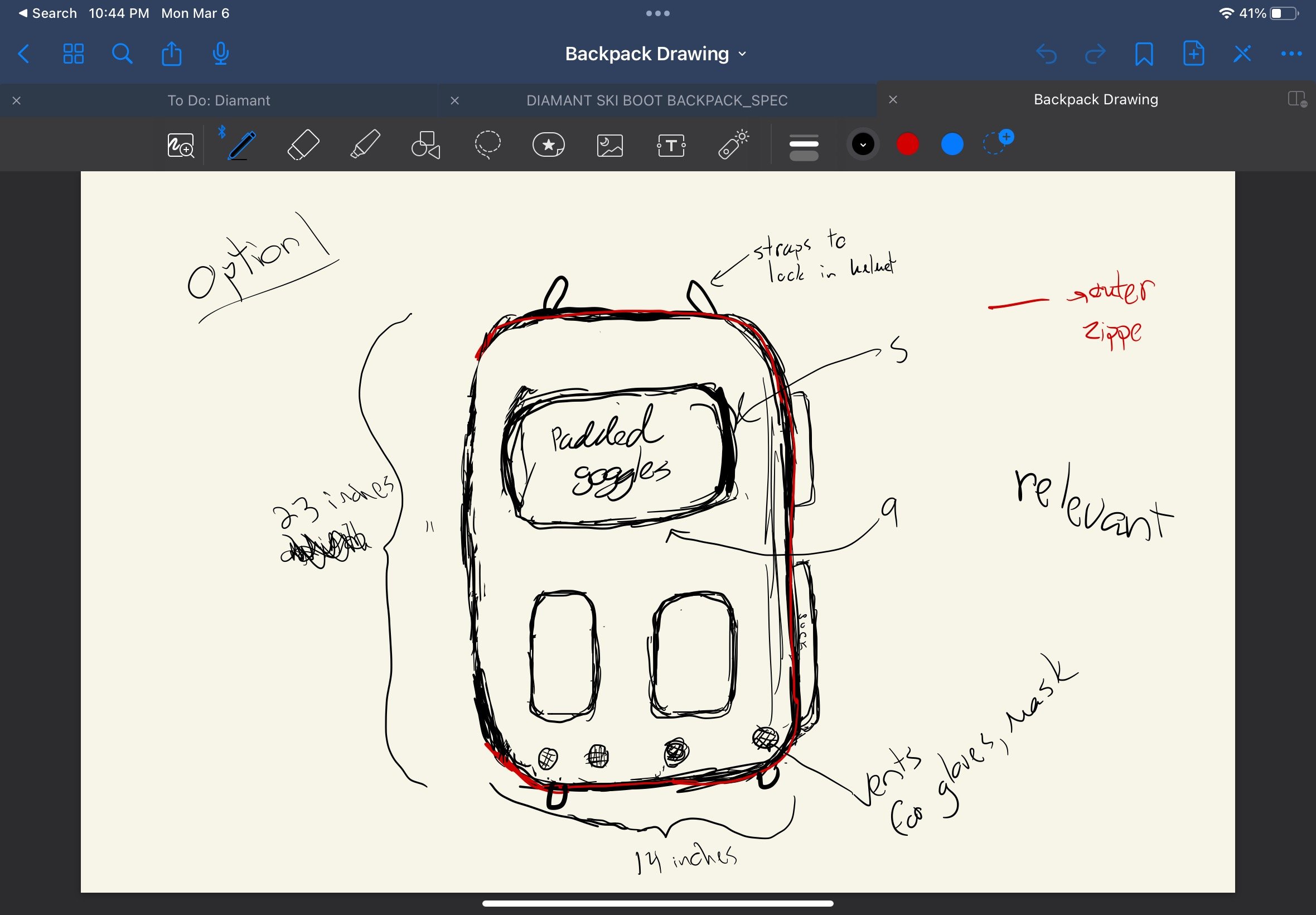A New Approach to Helmet Storage
When I first started designing The Weekend Warrior, the toughest challenge was figuring out how to carry a helmet without exceeding airline carry-on and personal item limits.
At first, the solution seemed simple: just strap the helmet to the outside of the bag.
My plan was to add two straps at the top where the helmet could buckle in. But in reality, the helmet would just swing freely every time the bag was moved, whether it was at your feet or in an overhead bin.
Looking back, this idea was, frankly, ridiculous.
Sketches of the original design. Yes, I thought two buckles was all we needed. Diabolical.
For starters, it would make the bag look like an unfinished prototype. But, more importantly, it would leave the helmet vulnerable to unnecessary impacts.
Why Helmet Placement Matters
Most modern ski and snowboard helmets are equipped with MIPS technology, which significantly reduces head trauma by absorbing the impact of collisions. But here’s the catch: MIPS helmets have a limited lifespan. After a few significant blows, experts recommend replacing the helmet, as the technology loses its effectiveness.
Ironically, putting your helmet inside a boot bag for “protection” actually causes the most damage.
Take, for example, the popular Transpack boot bag. It has two side compartments for boots and a central space for everything else including your helmet. Every time the bag is tossed into a car or onto the floor, the boots slam into the helmet. Over time, this repeated impact drastically reduces the lifespan of the helmets MIPS technology and general effectiveness. And this isn’t even from skiing / snowboarding!
This issue isn’t unique to the Transpack. Any bag that places the helmet between or near the boots runs the same risk. Even worse, if the bag is checked as luggage, the helmet may already sustain multiple crash like impacts before you even hit the mountain.
A New Approach
While designing The Weekend Warrior, I realized that an external helmet placement wasn’t just about meeting airline requirements - it was essential for protecting the helmet from damage.
By keeping the helmet outside the bag, we drastically reduce the risk of impact from ski or snowboard boots. Unlike traditional bags where every movement results in boots colliding with the helmet, our design ensures the helmet is only exposed to potential damage if the bag is deliberately dropped helmet-first.
The original Weekend Warrior with an all-elastic Helmet Canopy.
The first version of the Helmet Canopy was made entirely from elastic. The idea was twofold: elastic provides natural shock absorption and accommodates various helmet sizes, creating a one-size-fits-all solution. This was good, but we knew we could do better.
In version 2.0, we upgraded the canopy by combining elastic with ballistic nylon. This ultra-durable material offers even greater protection while maintaining flexibility for different helmet sizes.
The 2024 - 2025 Weekend Warrior (known as the Weekend Warrior 2.0) with the nylon and elastic blended canopy
With the helmet stored externally, we saw a noticeable decrease in damage during travel, whether by car or airplane. Separating the helmet from the clunk of boots and other gear keeps it safer throughout the journey.
The Airline Factor
Let’s talk about airlines.
Over the years, carry-on and personal item policies have, for the most part, relaxed across major airlines (though Spirit Airlines will still make you measure). Airlines are fairly lenient about what you bring on board, but if your bag doesn’t fit in the overhead bin, you’ll have to endure the dreaded gate check.
The problem with most boot bags is their thickness. Adding a helmet inside the bag makes them too bulky to fit in the overhead. For example, the Wildhorn boot bag has a 14-inch depth. While it may get past the gate agent, it’s never fitting in the overhead bin.
To ensure The Weekend Warrior stays within carry-on dimensions, we designed the helmet to sit at the top of the bag. This keeps the bag’s depth well within airline limits, even when fully packed. The helmet hugs the top edge of the bag, minimizing its impact on the overall length.
Even with the helmet attached to the Helmet Canopy, the bag fits securely in the overhead bin. The design ensures the helmet doesn’t stick out excessively, maintaining a sleek and streamlined profile. You can confidently walk onto a plane, place the bag in the overhead compartment, and avoid the frustration of having it gate-checked.
The Weekend Warrior 2.0 comfortably fits in the overhead on essentially every commercial jet in the United States and abroad.
Yes, I personally spent months testing this, hopping on flights, and physically measuring overhead spaces to make sure the dimensions were perfect. Whether it’s a regional jet or a larger international flight, The Weekend Warrior - with the helmet on top - fits without issue.
Even the new Weekend Warrior 50L fits up top without a problem (excuse the poor quality - this was taken after a red eye)
I get that having a helmet on the outside of the bag might feel counterintuitive after decades of traditional designs.
But the Helmet Canopy was engineered to solve two major problems: protecting your helmet and ensuring your boot bag meets airline requirements.
Sometimes, embracing a little change is worth it.





